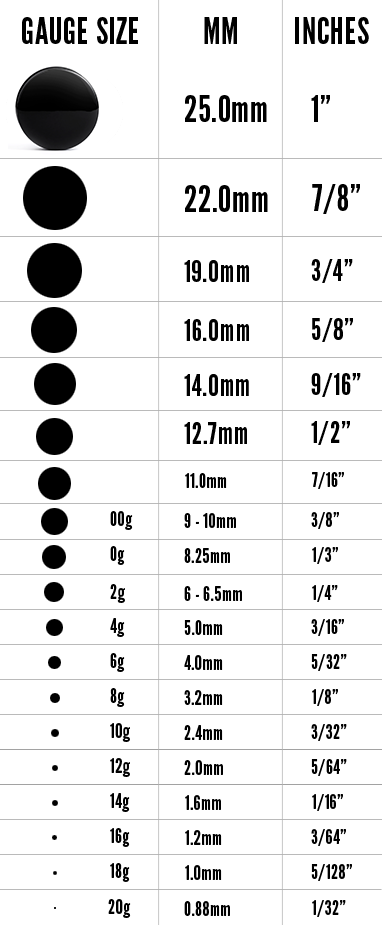
Find Out Everything You Need to Know About Ear Gauge Sizes
Looking for an ear gauge size chart to help you find the perfect fit? Look no further! Our comprehensive and accurate ear gauge size chart is your ultimate guide to finding the right size for your stretched piercings. Whether you're a newbie to ear stretching or an experienced enthusiast, our chart provides all the relevant information you need. With precise measurements and corresponding ear gauge sizes, you can easily navigate through various ear gauges and make informed decisions. Say goodbye to guesswork and browse through our detailed ear gauge size chart to ensure a comfortable and stylish fit for your stretched piercings.
Their are 2 main body jewelry measuring systems:
- Gauge ("G" or "GA")
- Millimeter ("MM")
Shortened ear gauge size chart with conversions for popular gauge sizes. Scroll down for the full conversion chart.

Popular Categories
Ear Gauge to MM and Inches Conversion Table
An ear gauge to mm and inches conversion table is a reference tool used to easily convert different gauge sizes commonly used for body piercings to millimeters and inches. This chart displays the corresponding measurements for each gauge size, allowing individuals to accurately understand the size of their ear piercings or jewelry. This table provides a clear comparison between gauge sizes, millimeters, and inches, assisting individuals in selecting the right jewelry or determining the appropriate stretching size for their piercings.
Use this ear gauge to mm and inches conversion table chart to make informed decisions when it comes to body jewelry and piercings.
Gauge | Millimeters(mm) | Inches |
|---|---|---|
20g | 0.8 mm | - | 18g | 1.0 mm | 5/128" |
16g | 1.2 mm | 3/64" |
14g | 1.6 mm | 1/16" |
12g | 2 mm | 5/64" |
10g | 2.4 mm | 3/32" |
8g | 3.2 mm | 1/8" |
6g | 4 mm | 5/32" |
4g | 5 mm | 3/16" |
2g | 6 mm | 1/4" |
0g | 8 mm | 5/16" |
00g | 10 mm | 3/8" |
| 11 mm | 7/16" |
| 12 mm | 1/2" |
| 14 mm | 9/16" |
| 16 mm | 5/8" |
| 19 mm | 3/4" |
| 22 mm | 7/8" |
| 25 mm | 1" |
| 29 mm | 1 1/8" |
| 32 mm | 1 1/4" |
| 35 mm | 1 3/8" |
| 38 mm | 1 1/2" |
| 41 mm | 1 5/8" |
| 44 mm | 1 3/4" |
| 48 mm | 1 7/8" |
| 51 mm | 2" |
What Is the Gauge?
The gauge is a measure of thickness. It was originally developed in the 1700s for measuring the thickness of electrical cables. In relation to body jewelry sizes, the gauge is the thickness of the bar or the external diameter of the ear plug or tunnel.
The unit for the gauge measuring system is 'g' or 'GA'. The smaller the number, the larger the gauge. For example, a regular ear piercing is 18g or 20g and the largest gauge is 00g. This is down to the gauge measuring system being created based on the number of holes the cable was pulled through, i.e. a cable pulled through 10 holes (10g) would be thinner than one that was pulled through 2 holes (2g).
After the largest 00g, we revert to inches. The next size up from a 00g is 7/16" and the sizes continue upwards in 1/16th of an inch. This may all sound a little complicated but we have some easy-to-read conversion tables to help you out.
Ear gauges aren't an exact measurement and can vary in size slightly between brands of plugs. This makes it tricky when stretching your ears because the size difference from gauge to gauge can be 1mm or 2mm. So it's best to use millimeters when stretching.
Why Are Gauge Sizes Backwards?
When it comes to body jewelry and piercings, many people wonder why gauge sizes seem to increase as the numbers decrease. This phenomenon occurs because gauge sizes are based on a system that originated in the wire industry, where smaller numbers represent thicker wires.
The concept was then applied to body jewelry, leading to the seemingly backwards progression of gauge sizes. It is important to understand this unique system in order to choose the correct size for your piercing to ensure a comfortable fit and proper healing. So, if you've ever asked yourself "why are gauge sizes backwards," now you know the reason behind it.
Choosing the Correct Gauge
Gauge sizes vary from 20g, 18g, 16g all the way up to 00g as shown on our ear gauge size chart. When the gauge is written as 'g' usually refers to ear tunnels and plugs. This is the measurement of the external diameter of the tunnel or plug.
The correct gauge for you depends on whether you will be stretching your ear to a new gauge or just replacing your current one. Either way, it's best to use our ear gauge size chart to convert to mm then it will be the accurate size you want.
For body jewelry, luckily there are standard piercing gauge sizes associated with common types of body piercings. For example, tongue, navel, and nipple bars are a standard gauge of 1.6mm. Nose piercings are usually 1mm but can vary from 0.8mm to 1.2mm. Lip and eyebrow bars usually have a gauge of 1.2mm or 1.6mm.
These are the gauges you would usually encounter when you buy body jewelry unless you specify otherwise. You can measure the gauge of the existing piece you have and decide if you want to stick with the same size or choose a different one.









